Ocean Acidification
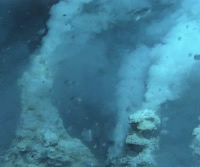 Ocean acidification is a critical global issue with serious ecological consequences. To mitigate and predict its effects requires a range of approaches. Although laboratory perturbation experiments are indispensable, they are often too short or too simplified to examine complex community adaptations to acidification. Underwater volcanoes produce local sites of chronically lowered pH due to magmatic gas venting, and provide important natural laboratories to study the impact of ocean acidification on individual species and complex ecosystems. The Earth-Oceans Interactions (EOI) Program is conducting this work at western Pacific submarine volcanoes that naturally emit large quantities of CO2 and SO2 that acidify the local environment. The sites described below are in the Mariana arc, and are part of the Mariana Trench Marine National Monument.
Ocean acidification is a critical global issue with serious ecological consequences. To mitigate and predict its effects requires a range of approaches. Although laboratory perturbation experiments are indispensable, they are often too short or too simplified to examine complex community adaptations to acidification. Underwater volcanoes produce local sites of chronically lowered pH due to magmatic gas venting, and provide important natural laboratories to study the impact of ocean acidification on individual species and complex ecosystems. The Earth-Oceans Interactions (EOI) Program is conducting this work at western Pacific submarine volcanoes that naturally emit large quantities of CO2 and SO2 that acidify the local environment. The sites described below are in the Mariana arc, and are part of the Mariana Trench Marine National Monument.
Latest update:
2014 Maug Expedition: An expedition on the NOAA ship Hi’ialakai, May 11-20, 2014, was focused on Maug island in the northern Marianas, which is a flooded caldera where volcanic CO2 vents directly into a shallow coral reef ecosystem. Preliminary results show that gradients in pH are created around the CO2 vents and they have a strong impact on the health and distribution of coral species around the vents. The site is an extraordinary natural laboratory where the effects of ocean acidification on marine ecosystems can be studied. This work is being conducted in collaboration with the NOAA the Coral Reef Ecosystem Division (CRED) of Pacific Islands Fisheries Science Center (PIFSC). In addition to the research at Maug, the cruise was able to locate the source of seismic signals produced by an underwater eruption in the area between April 24 – May 8 detected by the U.S. Geological Survey. A multibeam sonar survey over the summit of Ahyi Seamount showed dramatic depth changes from the previous survey in 2003, indicating that Ahyi was the source of the eruption sounds. CTD casts around Ahyi also found hydrothermal particle plumes coming from the summit. This cruise was funded in part by NOAA's Ocean Exploration and Research Program.
 |
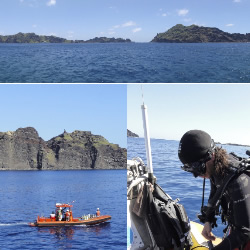 |
 |
| Coral reef communities at Maug. | Surface views of Maug. | Sampling the hydrothermal fluids and gases in the caldera. |
Maug Island
The island of Maug is an excellent site for ocean acidification research because it is a flooded caldera a top a much larger submarine volcano, and where CO2 vents directly into a shallow coral reef ecosystem. Preliminary work shows that gradients in pH are created around the CO2 vents and they have a strong impact on the health and distribution of coral species around the vents. This work is being conducted in collaboration with the NOAA the Coral Reef Ecosystem Division (CRED) of Pacific Islands Fisheries Science Center (PIFSC).
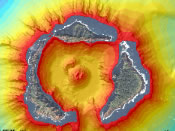 |
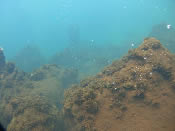 |
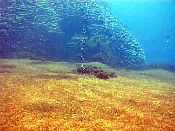 |
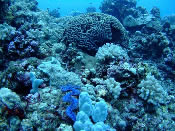 |
| Bathymetry of Maug | Reef affected by acidification | CO2 bubbles at Maug | Healthy Coral Community |
Eifuku Seamount
Another acidification natural laboratory is at NW Eifuku seamount which is unique because it vents liquid CO2 (the only known arc-seamount where this occurs), its CO2 output is the highest of any submarine hydrothermal site in the world, and because it hosts a surprisingly dense biomass of chemosynthetic mussels and other vent organisms. The shells of these chemosynthetic mussels are only half as thick as the same species elsewhere – they are so thin, in fact, that light shown from behind passes though them. Also, when a mussel dies at NW Eifuku, its shell dissolves so rapidly that it is gone before the animal’s flesh has a chance to rot or be eaten by scavengers.
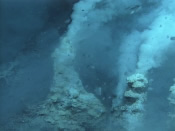 |
 |
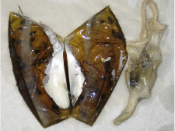 |
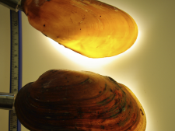 |
| High-CO2 vents at Eifuku | Mussels community | Mussel with dissolved shell | Shell thinned by high-CO2 |
